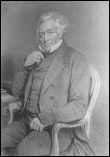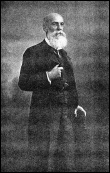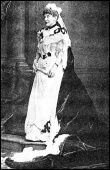
Click "thumbnails" to go to full size image
 |
 |
Sir
Thomas Edward Colebrook [owner
1859 - 1883]
Sir Thomas Edward Colebrooke Bart., born in 1813, was the only surviving son
of Sir Henry Thomas Colebrooke, the first great Sanskrit scholar of Europe. He
married Elizabeth Mary Richardson in 1857 with whom he had a son Edward Arthur
in 1861. In 1864 he gave land on the edge of the estate for the building of a
church, churchyard and vicarage. He also met the entire cost of construction
and endowed the church with £100 per year. In 1868 he pulled down the conservatories
at either end of the Mansion and moved the kitchens from the "Gothic Chapel" to
a newly built East wing. In 1869 he conveyed a further parcel of land for the
founding of a Church of England School which he sat on the school management
committee. Sir Thomas was MP for Lanarkshire and for many years he was chuchwarden
at Christchurch, even continuing in this role for several years after he sold
Ottershaw Park in 1883. From May 1882 until November 1883 when Ottershaw Park
was sold to Lawrence Baker, the property was leased by Reginald the 12th Earl
of Meath and his wife Mary.
Lady Meath was a philanthropist and founded several charities for the relief
of poverty worldwide including founding the Meath Home (now ICAN) in 1885 in
Brox Road. During
this time Edward Colebrooke's London address was 37 South Street, Park Lane,
London.
 |
 |
Lord and Lady Meath [leased Ottershaw
Park 1882-3]
From
May 1882 until November 1883 when Ottershaw Park was sold to Lawrence
Baker, the property was leased by Reginald the 12th Earl of Meath and
his wife Mary. Lady Meath was a philanthropist and founded several charities
for the relief of poverty worldwide including founding the Meath Home
(now ICAN) in 1885 in
Brox Road.
 |
Lawrence James Baker [owner
1883 - 1909]
Lawrence
James Baker bought Ottershaw Park in 1885 and moved from Haydon Hall,
Eastcote near Ruislip. He was stockbroker and in 1885-6 was MP for Frome and
later a Liberal candidate for Chertsey. In 1898 he became high Sheriff of Surrey.
He was churchwarden at Christ Church from 1884 until 1897. He was responsible
for the building of the cottages in Bonsey's Lane. He put the estate up for
auction in 1907 but it failed to sell. It was eventually sold to Sir
Fredreich Eckstein
in 1910 at which point he moved to Brantridge Park, Balcome, West Sussex. He
later moved to Brambridge Park near Eastleigh in Hampshire where he died
in
1921 aged 94.
 |
Sir
Friedrich Gustav Jonathan Eckstein [owner
1910 - 1921]
(Portrait
possibly by Sir William Orpen who is known to have painted several
members of the Eckstein family)
Sir Friedrich Eckstein was a German born on 9th April 1857 in Birkach
near Stuttgart. He pioneered the development of South African
gold mines together with his brother,
Hermann Eckstein, founder of the famous Witwatersrand mining house of H Eckstein & Co.
(Corner House) in 1887. Later he was a partner in the Werner Beit Co. of London.
He succeeded Sir Julius Weinher as Chairman of the Central Mining & Investment
Corporation, but was finally forced out of office by anti-German hysteria that
broke out at the beginning of the First World War. From 1888 Eckstein lived
in Johannesburg where he had a grand house called Warrington Hall in the suburb
of Doornfontein. He married Catherine Mitchell of Kimberley on 30th April 1890
with whom he had a a daughter, Herminie Beatrice and a son, Bernard Friedrich,
and in 1901 he moved to England, first to The Walsingham Hotel, Piccadilly
and
then to 18 Park Lane, London. He was granted Brithish nationality in 1906.
He bought the main part of Ottershaw Estate on January 1st 1910 and several
other
adjacent lots from various other landowners later that year.
He
greatly improved and enlarged the estate and demolished the existing mansion
to build
a larger
one
in its place.
It is said that his wife did not approve of the new mansion and refused to
live in it. In addition, he made many other improvements to the estate including
the
enlargement of the North lodges and erected of a pair of ornate wrought iron
gates between them. The kitchen gardens were redesigned and four cottages were
converted to form Durnford Lodge. Furthermore, the Bothy may have been substantially
altered at this time. When he moved from Ottershaw in 1919 he took up residence
at Oldlands Hall, Fairwarp, Sussex where he died and was buried in 1930.
He was
created
a baronet in 1929 for "services to the inhabitants and Government of Sudan".
His
wife
died
in
1935
in
Manaus,
Brazil.
 |
Miss
Susan Dora Cecilia Schintz [leased
1919 - 1921; owner 1921 - 1931]
Susan Dora Cecilia Schintz was born in Liverpool
early in 1869, daughter of the Swiss born Hans Gaspard (c.1837
- 1912) and his wife Anna
Julia nee Bleuler (1843 - 1921). Hans Gaspard had made his fortune
from the extraction of nitrates in northern Chile and was director
of
the New Tararugal Nitrate Company and Messrs Schintz & Co.
of Liverpool. He became a naturalised British subject
in 1875. After his marriage to Anna the family
lived in the vicinity of
Liverpool;
in
the 1870's
at Sandfield Park,
West Derby, in
1881
in Sefton Park, Toxteth, in 1891 in Mossley House,
Wavertree and from 1901 to 1922 at Childwall Hall.
In 1906 her parents gifted her Thickthorn estate (now Kenilworth Manor, a nursing home) in Kenilworth, Warwickshire where she had a stud for hackney horses. Before WWI she showed them at many prestigious events around the country and was a frequent prize winner. Miss Schintz had an elder brother, Hans Gaspard Ferdinand Max (known to some as "Mad Max"), an old Harrovian, who died in Switzerland during a climbing accident in 1912. She also had an elder sister, Julia Lucy who married John Smith Moreton in 1897 and lived the rest of her life at South Pickenham Hall in Swaffham, Norfolk. Han Gaspard (the father) also died in 1912 and Miss Schintz inherited more than £300,000 in a trust from which she received a substantial private income, and an interest in a Land company in Argentina.
The Schintz's gave generously to charity. £20,000 was allocated for such purposes by her mother from her father's estate much of it going to local hospitals. Miss Schintz being her own words "addicted to charity" was personally involved with the Liverpool's Home for Incurables before and during WWI and regularly entertained patients at her Thickthorne Estate. During WWI she fully financed an auxilliary military hospital at Arrowe Hall, Birkenhead, near Liverpool which cared for up to 300 wounded soldiers. After the war she financed the Schintz Nursing Home in Liverpool.
In 1919 she bought Hurtwood Edge near Cranleigh, Surrey (which in 1970 became the home of Eric Clapton) but at about the same time took up residence at Ottershaw Park, presumably leasing it from the owner, Friedrich Eckstein. Why she should want two properties in Surrey is a mystery. Only later was the estate conveyed to her. The Argentinian property was sold in 1921 and Hurtwood Edge and the Thickthorne estate had been sold by 1923.
The Ottershaw estate, including the outlying farms and cottages cost Miss Schintz £100,000 and she spent and additional £25,000 on improvements. Her gardeners Alfred Dyer and his uncle, Arthur Lawrence, together with their families came with her from Childwall Hall as did her Garage Foreman and Chauffeur, Frederick Lionel Rapson. Miss Schintz later said she moved to Ottershaw for the sake of her elderly mother who had suffered emotionally from the tragic deaths of her son and husband. Miss Schintz believed her mother would benefit from the beautiful countryside of Surrey and she was often to be seen pushing her mother around the estate in an invalid chair. Incidentally, this chair was amongst the items auctioned in the 1930 sale of household effects having in the meantime been stored in the garage at the Bothy! Sadly, her mother died on 22nd September 1921 the day before the Ottershaw Estate was finally conveyed to her. Miss Schintz was left a little over £60k in her mother's will.
It was while she was running Arrowe Hall Hospital that her life became inextricably linked with that of Frederick Lionel Rapson (click for an article about Rapson). Rapson had been injured during WWI and was sent to Arrowe Hall to recover. When he was sufficiently recovered he took on the role of a Red Cross worker at the hospital but later was employed by Miss Schintz as the family garage foreman and chauffeur at Childwall Hall. Rapson was a born inventor and Miss Schintz supported his commercial activities financially. She did this through a number of loans and share purchases, but her money was rapidly lost as the enterprises failed. To finance her investments she attempted to sell the Ottershaw estate at auction in November 1921 but the sale failed but she nevertheless continued to support Rapson until the drain on her finances were so great that she was declared bankrupt in 1930. During proceedings at Kingston Bankruptcy Court her Trustee in Bankruptcy maintained that she had been cheated by her principal mortgagee, Joseph Wyatt, who had furthermore acted as an illegal money lender. Rapson was implicated and accused of influencing her into partng with her money and the national press had him marked down as a gold digger. There was a long and complicated series of exchanges culminating in an undisclosed out of court settlement in 193*.
There is a record of two van loads of pictures being taken to Switzerland in 1927 for Miss Schintz and Rapson recovered expenses in 1930 in respect of a trip there to advise on values of paintings. It appears that in advance of her bancruptcy Miss Schintz was setting aside investments for a rainy day. It also suggests that Miss Schintz herself was also in Switzerland at these times and may have been a frequent visitor to the land of her father.
In October 1930 the contents of the Mansion were auctioned, with thousands of people reported to have attended the viewings. In the same month the entire estate was offered at auction but only outlying farms were sold. At a subsequent auction in May 1931 several small plots including No 1 Bonsey's Lane, land on the western side of the estate, the North Lodges and a plot on Chobham Road (Wethersfield) were sold but there were no bidders for the rest of the estate.
Miss Schintz meanwhile had left Ottershaw and moved to Eastbourne first as resident at the St John's Hotel de Luxe in Selwyn Road where she was bedridden throughout the bankrupcy proceedings of 1930 and 1931. Other hotel residents knew her as the "mystery woman" owing to her reticence and refusal to mix with others and a Harley Street doctor diagnosed her as suffering from neurasthenia, insomnia and depression. A Daily Mail reporter who paid her a visit wrote that she was a frail and gentle woman living among the bare remnants of her great fortune. Rapson also moved to Eastbourne with his family and according to Miss Schintz they were her only friends. He was still acting as her personal secretary and chauffeur and visited her regularly. During this period she was supported financially partly by an allowance from her sister.
In Eastbourne she was attended by her doctor, the notorious Dr John Bodkin Adams who seems to have involved himself in her personal affairs. Although tried and acquitted of murder in 1957, since Adam's death in 1983, evidence has emerged to suggest he may have helped up to 25 of his patients to their graves, after first influencing them to name him in their wills. Amongst the numerous bequests which he received were two Rolls Royces, and as early as 1933 he was a beneficiary of one of his patient's wills. One could be forgiven for speculating that Miss Schintz may have been in his sights as a potential victim!
Although Miss Schintz spent only a very short time living at Ottershaw she obviously grew to love the place as it is said that the terms of sale of the Estate allowed her to return annually to sit on the terrace and look at the view over the lakes which she loved so much. Whether she ever did return is not known. Whilst at Ottershaw she continued to drive hackneys which were probably stabled at Home Farm. It is reported that sixteen animals were destroyed when she left Ottershaw as she was concerned that another owner might mistreat them. She was very kind to her servants and at Christmas took the children from the estate in her Rolls-Royce to the pantomime and treated them with sweets and chocolate.
In 1933 Rapson died and his son Freddie took on the role of chauffeur and secretary. Miss Schintz recovered from her depression and, determined to clear her name and that of Frederick Rapson, spent several months with Freddie's assistance preparing a 50 page dossier in support of her case. She applied for a hearing in 1936 and in January In 1937 she appeared finally in Kingston Bankrupcy Court with Freddie in support where she again alledged she had been swindled by her advisors and that Rapson was innocent of any malpractice. Her case was again front page news and most daily newspapers carried the story. She returned to Switzerland immediately after the court proceedings too ill to await the result which was announced later that year. She was eventually cleared of bankruptcy in 1938. She appears to have stayed in Switzerland until after WWII. In 1946 after a brief visit to England she returned there once again this time to a rented villa at Hertenstein on the shores of Lake Lucerne. Miss Schintz ended her days back in England first at the Piccadilly Hotel in London but by 1952 she had moved to Broome Park, a residential country hotel between Maidstone and Dover and died in the Kent and Canterbury Hospital on 12th June 1954. Her final place of rest is unknowm. In her will she left what little there was of her fortune to a number of former employees including several from Ottershaw Park.
 |
Arthur
E Foot CBE [Headmaster
1948 - 1964]
Arthur
Foot was the first headmaster of Ottershaw School. He
had previously taught at Doon School in India where
he had made
an outstanding contribution for which he had been awarded
the CBE. Quoting from Goldsmith's (1973) account "The
Headmaster not only exercised a powerful influence in
shaping the character of the school but his capacity
for work enabled
him to add 20 teaching periods to his other duties,
thus strengthening the Science and Mathematics side.
His Maths
examples usually showed an Indian influence; boys would
be asked the calculate the speed of a fully-loaded elephant
travelling from Calcutta to Bombay.
 |
Allan Dodds [Headmaster
1964 - 1982]
Allan
Dodds was appointed as Headmaster in 1964 from a very large
number of candidates. Mr Dodds was a Cambridge graduate and had previously
taught at St Peter's Scool in York. He was founder of the Boarding
Scools Association and was appoined as a JP. He was also elected
to the Headmasters' conference, the only Headmaster of a local
authority
boarding school to be a member. Mr Dodds successfully saw the
school through a rapidly changing educational climate until its closure
in 1981.